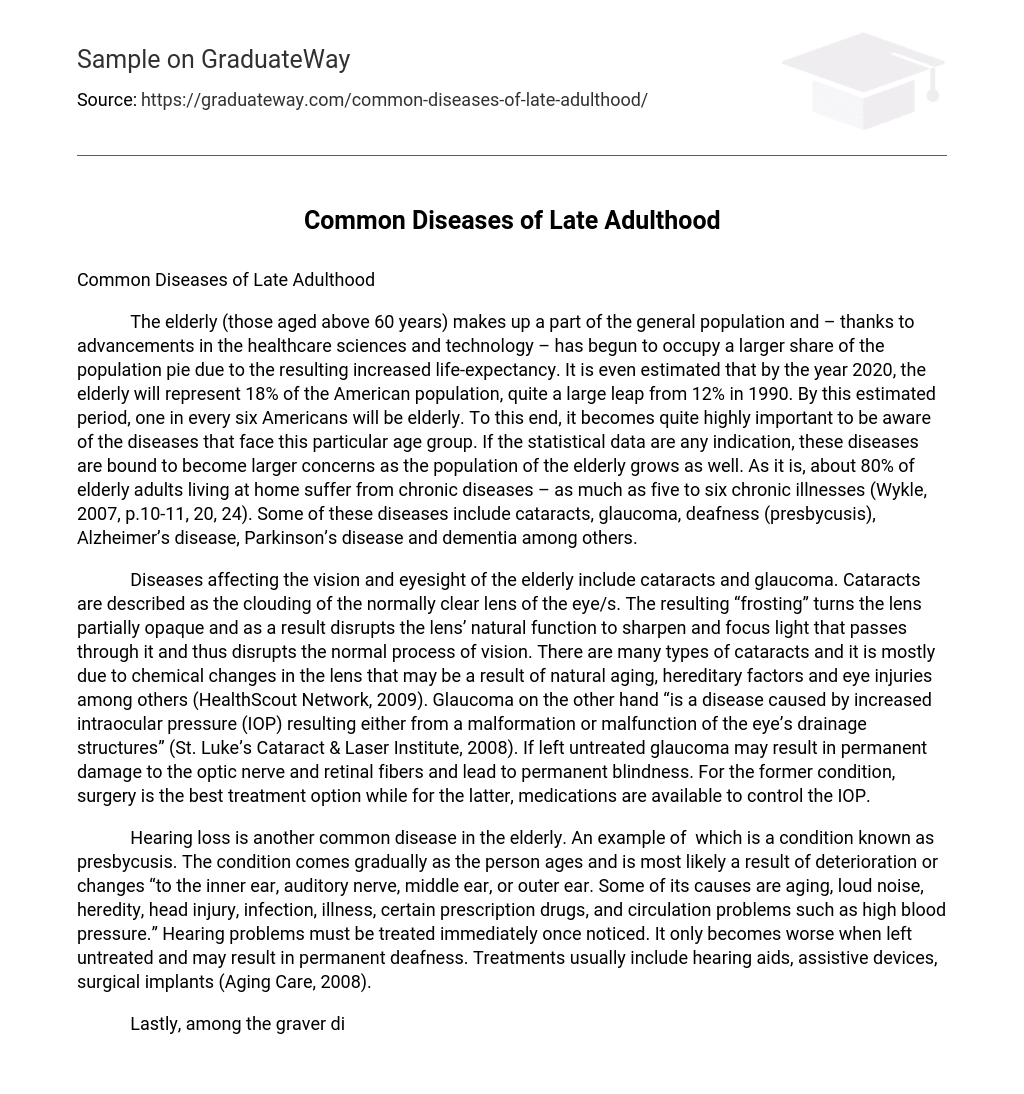Common Diseases of Late Adulthood
The elderly population, those aged above 60 years, make up a significant portion of the general population. Thanks to advancements in healthcare sciences and technology, they have begun to occupy a larger share of the population pie due to increased life expectancy. It is estimated that by the year 2020, the elderly will represent 18% of the American population – quite a large leap from 12% in 1990. By this estimated period, one in every six Americans will be elderly. Therefore, it becomes highly important to be aware of diseases that affect this age group as these diseases are bound to become larger concerns as the population grows older. Currently, about 80% of elderly adults living at home suffer from chronic diseases – as much as five to six chronic illnesses (Wykle, 2007). Some common diseases among this age group include cataracts, glaucoma, presbycusis (deafness), Alzheimer’s disease, Parkinson’s disease and dementia.
Diseases that affect the vision and eyesight of the elderly include cataracts and glaucoma. Cataracts are described as the clouding of the normally clear lens of the eye. The resulting frosting” turns the lens partially opaque, disrupting its natural function to sharpen and focus light passing through it, thus disrupting normal vision processes. There are many types of cataracts, mostly due to chemical changes in the lens that may result from natural aging, hereditary factors, or eye injuries (HealthScout Network, 2009). Glaucoma is a disease caused by increased intraocular pressure (IOP) resulting either from a malformation or malfunction of the eye’s drainage structures (St. Luke’s Cataract & Laser Institute, 2008). If left untreated, glaucoma may cause permanent damage to optic nerves and retinal fibers leading to blindness. For cataracts surgery is typically recommended while for glaucoma medications can control IOP.
Hearing loss is a common disease among the elderly, one example of which is a condition known as presbycusis. This condition comes on gradually as a person ages and is most likely a result of deterioration or changes to the inner ear, auditory nerve, middle ear, or outer ear. Some of its causes are aging, loud noise exposure, heredity, head injury, infection or illness, certain prescription drugs and circulation problems such as high blood pressure.
It is important to treat hearing problems immediately once they are noticed. If left untreated it only becomes worse and may result in permanent deafness. Treatments usually include hearing aids, assistive devices and surgical implants (Aging Care 2008).
Lastly, among the graver diseases to which the elderly are predisposed are those related to the degeneration of mental and nervous functions, such as Alzheimer’s and Parkinson’s disease. Alzheimer’s disease is a progressive and fatal brain disease that destroys brain cells, causing problems with memory, thinking, and behavior. It is the most common form of dementia and still has no cure as of today. According to the Alzheimer’s Association (2009), today it is the sixth-leading cause of death in the United States.” Like Alzheimer’s, Parkinson’s disease also involves a progressive loss of nerve cell function in parts of the brain that manage muscle movement. Its symptoms include:
People with Parkinson’s disease may experience tremors or shaking due to damage to their nerve cells. These tremors tend to worsen when the person is at rest but improve when they move. The tremor can affect one side of the body more than the other and may impact the lower jaw, arms, and legs (American Academy of Family Physicians, 2008).
Like Alzheimer’s, the etiology of Parkinson’s is also unknown. Similarly, there is no cure for Parkinson’s; however, medications can help control the symptoms of the disease.
References
Aging Care (2008) provides information on health conditions, specifically hearing loss. The article is published by MediaBrains Inc and can be accessed at http://www.agingcare.com/Health-Conditions/1197/Hearing-Loss/. The article was retrieved on January 24, 2009.
The Alzheimer’s Association (2009) provides information about what Alzheimer’s disease is. According to the association, Alzheimer’s disease is a progressive brain disorder that affects memory, thinking skills and behavior. It is the most common cause of dementia in older adults. For more information on this topic, visit the Alzheimer’s Association website at http://www.alz.org/alzheimers_disease_what_is_alzheimers.asp.
The American Academy of Family Physicians (2008) provides information on Parkinson’s disease. The website, www.Family-Doctor.org, offers insights on the topic. Retrieved on January 24, 2009 from http://familydoctor.org/.
Online resource for information on common brain disorders: famdocen/home/common/brain/disorders/187.html
HealthScout Network (2009) provides a health encyclopedia that covers various diseases and conditions. One of the topics included is cataracts. The information can be accessed by visiting their website at http://www.healthscout.com/ency/68/114/. This resource was last retrieved on January 24, 2009.
Main page link: Causes and Risk Factors of Cataracts
St. Luke’s Cataract & Laser Institute (2008) provides information on eye conditions, specifically glaucoma. The website can be accessed at www.stlukeseye.com/conditions/Glaucoma.asp and was retrieved on January 24, 2009.
Wykle, M.L. (2007) discusses health disparities in late adulthood in a publication from the University of Washington School of Nursing.





